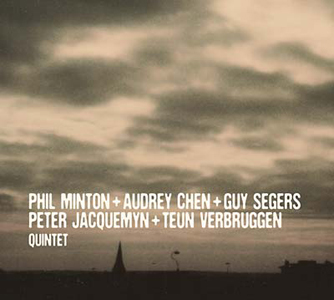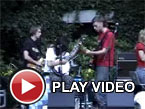Minton/Chen/Segers/Jacquemyn/Verbruggen Quintet, "Four Instruments Two Voices"
 The fundamental elements of singing and vocalizing are easy to miss in most music. All singers, even the very worst, unconsciously coordinate the various processes required to sing musically, so that respiration, phonation, resonation, and articulation collapse into sung phrases or wordless melodies. Phil Minton and Audrey Chen work to undo that coordination. They break their voices down, emphasizing the dental clicks, nasal hums, and various fleshy noises typically masked by melodies and lyrics. Many of the sounds they produce as part of this quintet—which features two basses, percussion, and cello—are the kind most singers would try to play down. By giving them the spotlight, Phil and Audrey are forced to express themselves in the same way instruments do.
The fundamental elements of singing and vocalizing are easy to miss in most music. All singers, even the very worst, unconsciously coordinate the various processes required to sing musically, so that respiration, phonation, resonation, and articulation collapse into sung phrases or wordless melodies. Phil Minton and Audrey Chen work to undo that coordination. They break their voices down, emphasizing the dental clicks, nasal hums, and various fleshy noises typically masked by melodies and lyrics. Many of the sounds they produce as part of this quintet—which features two basses, percussion, and cello—are the kind most singers would try to play down. By giving them the spotlight, Phil and Audrey are forced to express themselves in the same way instruments do.
Four Instruments Two Voices is one of two Audrey Chen and Phil Minton albums released this year by Sub Rosa, both of which focus on extended vocal techniques. This one matches their voices with Guy Segers' electric bass, Peter Jacquemyn's double bass, and Teun Verbruggen's percussion. As might be expected from instrumentalists who have worked with the likes of Peter Brötzmann, John Butcher, and William Parker, the music is improvised and mostly chaotic. But because Chen and Minton's vocal contortions lead the group, and because there isn't another wind instrument around, much of the record has a loose and open feel. All the vocal frying and plosive noises they make with their mouths come through loud and clear, from the spit-filled vibrations of their lips to the raspy hiss of their closed windpipes.
Such physical noises make for tense music. When Chen and Minton choke sounds out, my body involuntarily seizes up, and their moans have a way of drawing my shoulders up against my neck. When the band reacts to them in sympathy, the effect is darkly atmospheric and unsettling, as on "Eight" and "Nine." But not everything is quite so serious. On "Three," Minton and Chen's gaseous vocalizations are paired with a squealing cello and a wobbly rhythm section that sounds absolutely lost. It's hard not to laugh at how ridiculous it all seems, and at times I think it sounds like the musical version of a slapstick comedy.
For "Six" their growls and wordless interjections are recast as part of a quiet drama filled with bird-like whistling, ominous bass melodies, and flitting percussive sounds. The band's muted performance fosters a calmer atmosphere, and Phil and Audrey both sound more subdued throughout, but it's hard to tell whether the band is responsible for controlling the mood or if they're following the vocalists' lead. Later in the album Segers plays several naked melodies, and I think those color the way I'm hearing the voices. Either way, though the techniques are unconventional "Six" is a relatively pretty song. It's a solid example of how extended vocal techniques can be used to produce musically pleasant and expressive results without relying on a singer's vocal quality or resorting to familiar melodic techniques.
In the liner notes Minton writes, "This music is first a matter of extra-lingustic expression, the idea of going beyond the word's meaning, an exploration that doesn't stop at letters... but extends to all in-between-sounds made possible by the tongue/oral cavity/breath configuration." I don't know if Phil or Audrey's performances go beyond words, but their fragmented noises and stripped down vocal utterances do get at feelings and expressions differently than conventional singing does. Rather than going beyond anything, I get the sense that they're digging down, drilling into the voice and looking for meaning and expressiveness where most would hear nonsense. Whatever the theoretical framework is, the content is unique and varied—the kind of music that encourages lateral thinking and hearing ostensibly familiar sounds anew.
 
samples:
 



